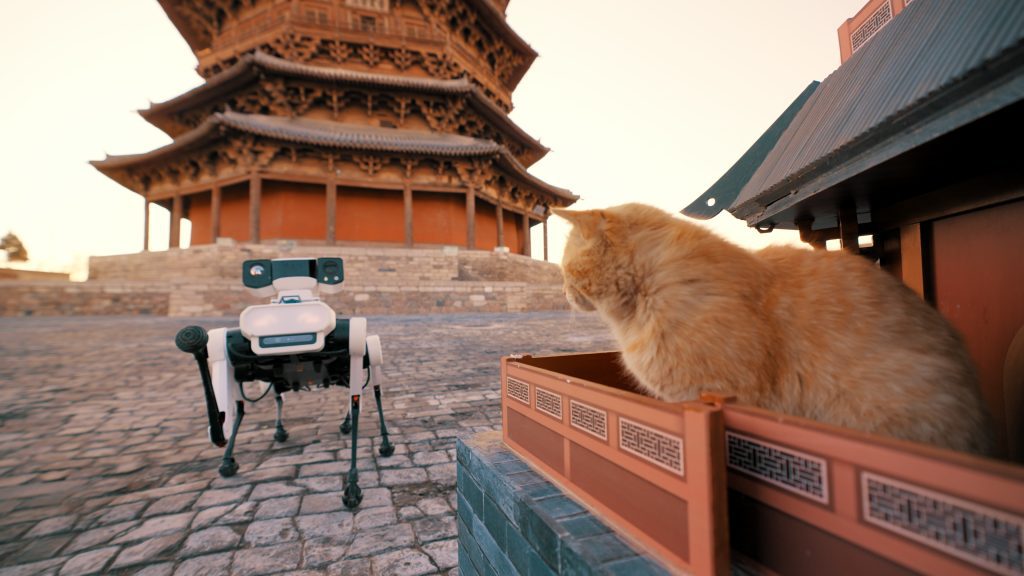Last year, in partnership with Tsinghua University’s School of Architecture, Lenovo unveiled Smart Yingxian Wooden Pagoda 1.0: an AI-powered digital experience that recreated five levels of the pagoda based on historical references and creative interpretation. While only the first level of the real tower remains open to the public for preservation reasons, the virtual model allowed visitors to explore scenes from the upper stories in a safe and immersive way.

Why 2.0?
On April 23 at Tsinghua’s Architecture Hall, Lenovo and Tsinghua University – the Palace Museum Joint Research Center for Cultural Heritage took the next step. Smart Yingxian Wooden Pagoda 2.0 isn’t just a model—it includes Lenovo Daystar Robot, a six‑legged robotic dog actively monitoring the pagoda.
By combining Lenovo’s AI, spatial‑computing, and robotics leadership with Tsinghua’s deep heritage expertise, we tackle three long‑standing hurdles in ancient‑wood conservation:
- Access to inaccessible spaces
Delicate ceilings, hidden eaves, narrow beams—places scaffolds and humans can’t safely reach. - Tracking time’s impact
Without data over time, small cracks or shifts can go unnoticed—until it’s too late. - Minimizing contact with fragile structures
Manual scanning requires setup and touch. Both risk damaging aged woodwork.

Embodied Intelligence System: Lenovo’s answer
At the heart of Smart Yingxian 2.0 is Lenovo’s Embodied Intelligence System—a next-gen integrated solution that gives machines physical agency in cultural preservation.
Here’s what it enables:
- High-speed, zero-touch 3D modeling
In just two hours, our robot captured a detailed 3D model of the pagoda’s caisson ceiling—work that previously required days and scaffolding. The result? A rich, dynamic digital twin that supports long-term structural analysis and planning. - Six-legged, bio-inspired mobility
Its adaptive legs respond to terrain in real time, maneuvering safely through the pagoda’s ancient geometry. Every autonomous scan enhances our preservation data, supporting predictive, AI-driven conservation.
A New Era of Cultural Stewardship
With Smart Yingxian 2.0, preservation shifts from reactive to proactive. Lenovo’s Daystar Robot isn’t just documenting history—it’s actively preserving it in real time. Each circuit uncovers new insights, and every scan deepens our understanding. It’s heritage preservation with eyes, legs, and a brain.
“The Smart Yingxian Wooden Pagoda 2.0 project is more than just innovation,” said Mao Shijie, vice president of Lenovo and head of Lenovo Research Shanghai. “It showcases Lenovo’s ongoing commitment to leveraging AI for the protection and preservation of cultural landmarks.”
Now, with version 2.0, that innovation takes a leap forward—it becomes a living archive that evolves with the pagoda, turning AI and robotics into active caretakers of history.

And this is just the beginning.
What’s next?
The Yingxian Wooden Pagoda is our pilot—but it won’t stop there.
We are already exploring community partnerships to deploy AI at other historic sites. Imagine AI companions moving through dragon-carved rafters, scaling century-old beams, and scanning every joint and crack—quietly preserving our shared history.
By fusing tradition with cutting-edge technology, we are creating a replicable blueprint for global heritage protection—ensuring that these wonders not only survive but thrive for generations to come.
